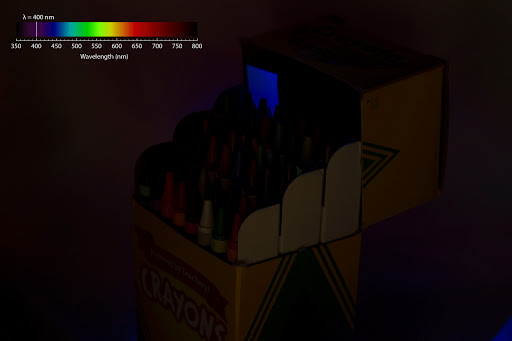|
This was another fun photo to take. This photo should display an animate gif of a box of crayons under monochromatic illumination with light wavelengths ranging from 400 nm to 700 nm and also under normal white light. I know that other students have uploaded animated gifs before. I can't see the animation here, but hopefully it will work for the peer reviewers.
I created these pictures in my group's lab at Stanford. I regularly use a solar simulator light source for my solar energy-related research. When I first read the Light and Color requirement, I immediately thought of using my group's lamp and monochromator for the colored light source. After a bit of thinking, I decided that a box of crayons would be a cool subject because it contains many different colors.
I took this series of photos pretty quickly so that I would not interfere with the other lab members who needed to use the lamp for actual research, so this experiment wouldn't meet the rigorous standards that I'd normally apply to my lab work, but I think it is pretty good for the purposes of this class. The light source is a 1000 W xenon arc lamp that produces white light that is a good approximation of the solar spectrum. To generate light of (nearly) a single wavelength, I used our monochromator, which employs a diffraction grating to separate the photons of different energies from the white light. I selected wavelengths ranging from 400 nm to 700 nm in 25 nm increments. I optimized the settings of the monochromator to achieve the highest possible intensity, which meant I had to compromise on the spectral purity. The wavelengths I indicated in the gif are the peak wavelength for each illumination condition, but the light also contains other wavelengths within approximately +/- 20 nm of this peak.
To take the photos, I set my camera on a tripod and focused on the box of crayons. I placed a small piece of white paper at the top of the box as a white reference. I used an aperture of f/5.6 to gather light quickly, and ISO of 100 for low noise, and a 1 s shutter speed for a proper exposure. For the full spectrum white light illumination, the light intensity was higher, so in this case I used a shutter speed of 1/20 s. For all the photos, I set the white balance on my camera to daylight. This corresponded to a color temperature of 5200 K on my Canon camera.
After capturing the images, I did not perform any of my usual adjustments with Adobe Camera Raw I opened the photos in Photoshop straight away. I set up the photos in a stack. I added in the visible spectrum with some labels and the wavelength marker and superimposed this image on each frame to display the illumination condition. Then I used the timeline to create an animated gif. I chose the animation because I think it highlights how certain crayons change color dramatically with small changes in the illumination wavelength. For example, note the crayons near the upper left of the box in the wavelength range of about 500 nm to 600 nm. I really like watching the colors change with different wavelengths.
One downside to the animated gif format is that it only allows for 256 colors. In spite of this shortcoming, in my opinion this gif still displays the colors of the various crayons clearly enough to be interesting and useful.
One other important note: the photos at 400 nm and 700 nm look very dim, but close to normal (i.e. white light) coloration. The intensity of the illumination under these conditions was definitely sufficient to be detected by my eye, but I think these wavelengths are not detected by the camera's sensor. The reason that the crayons appear dim but normal colored is that there was some stray light that leaked into this setup from the room. We have a black shroud that prevents outside light from leaking into the system during our measurements, but I couldn't fully enclose the system in the shroud without blocking the camera, so some ambient light leaked in. If I were to do this experiment again, I would design a better light blocking system to make sure that the monochromatic light was always the only important light source.
|
